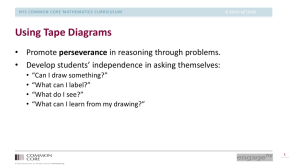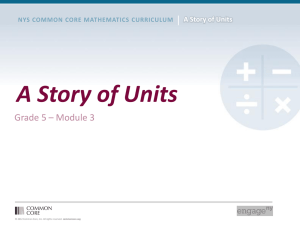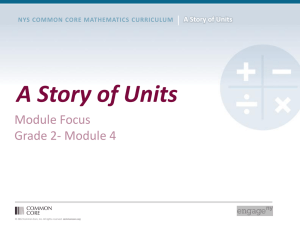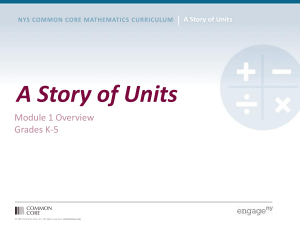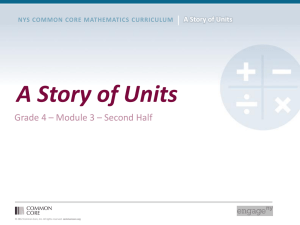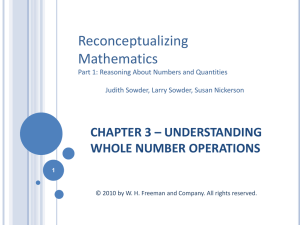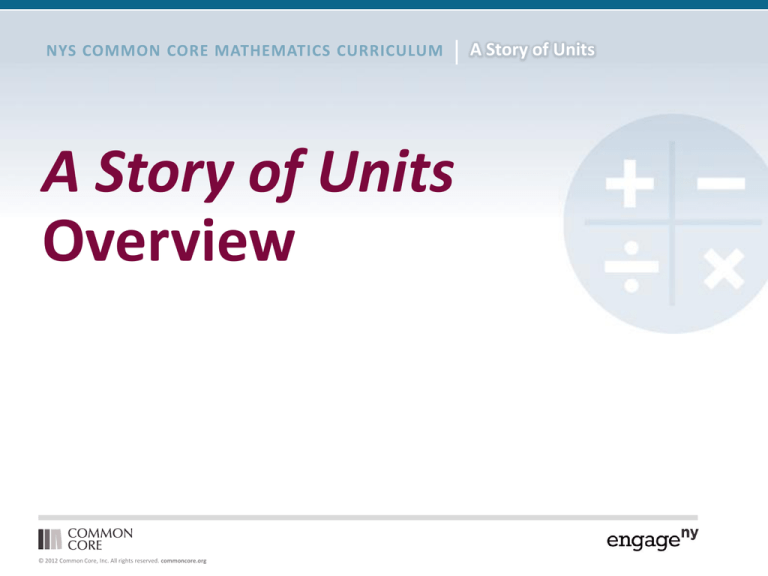
A Story of Units
A Story of Units
Overview
© 2012 Common Core, Inc. All rights reserved. commoncore.org
A Story of Units
The Shape of Math in A+ Countries
Mathem
atics
topics
intende
d at
each
grade
by at
least
twothirds of
A+
countrie
s
© 2012 Common Core, Inc. All rights reserved. commoncore.org
Mathema
tics
topics
intended
at each
grade
by at
least
twothirds of
21 U.S.
states
2
A Story of Units
Instructional Shifts
3
© 2012 Common Core, Inc. All rights reserved. commoncore.org
A Story of Units
Curriculum Map
Test Date
Pre-Kindergarten
Kindergarten
Grade 1
9/6/12
Grade 2
Grade 3
*M1: Sums and Differences
(10 days)
20 days
M1: Analyze, Sort, Classify,
and Count up to 5
(45 days)
10/10/12
M1: Classify and Count
Numbers to 10
(43 days)
M1: Multiplication and
Division with Factors of 2, 3,
M2: Addition and Subtraction
4, 5, and 10
with Length, Weight,
(25 days)
M1: Addition and Subtraction
Capacity, and Time
of Numbers to 10 and Fluency
Measurements
(45 days)
(20 days)
20 days
11/8/12
M3: Place Value, Counting,
and Comparison of Numbers
to 1000
(25 days)
M2: Identify and Describe
Shapes (7 days)
20 days
M2: Analyze, Compare,
Create, and Compose Shapes
(15 days)
12/11/12
M3: Comparison with Length,
Weight, and Numbers to 10
(43 days)
20 days
1/17/13
20 days
M3: Count and Answer "How
Many" Questions up to 10
(50 days)
M2: Place Value,
Comparison, Addition and
Subtraction of Numbers to 20
(35 days)
M4: Addition and Subtraction
of Numbers to 1000
(35 days)
M3: Ordering and Expressing
Length Measurements as
Numbers
(15 days)
Grade 4
M1: Place Value, Rounding,
Fluency with Addition and
Subtraction Algorithms of
Whole Numbers
(25 days)
*M2: Unit Conversions
(7 days)
M2: Problem Solving with
Mass, Time, and Capacity
(25 days)
M3: Multiplication and
Division with Factors of 6, 7,
8, and 9
(25 days)
M4: Multiplication and Area
(20 days)
M3: Multiplication and
Division of up to a 4-Digit
Number by up to a 1-Digit
Number Using Place Value
(43 days)
M4: Addition and
Subtraction of Angle
Measurements of Planar
Figures
(20 days)
Grade 5
M1: Whole Number and
Decimal Fraction Place Value
20 days
to the One-Thousandths
(20 days)
20 days
M2: Multi-Digit Whole
Number and Decimal
Fraction Operations
(35 days)
20 days
M3: Addition and Subtraction
of Fractions
(22 days)
M4: Multiplication and
Division of Fractions
(38 days)
20 days
20 days
2/15/13
20 days
3/22/13
20 days
M4: Describe and Compare
Length, Weight, and Capacity
(35 days)
M5: Preparation for
M4: Place Value,
Multiplication and Division M5: Fractions as Numbers on
Comparison, Addition and
Facts
the Number Line
M4: Number Pairs, Addition
Subtraction of Numbers to 40
(40 days)
(35 days)
and Subtraction of Numbers
(35 days)
to 10
(47 days)
M5: Identify, Compose, and
Partition Shapes
(15 days)
4/29/13
20 days
M5: Write Numerals to 5,
Addition and Subtraction
Stories, Count to 20
(35 days)
5/28/13
20 days
M5: Numbers 10-20, Counting
to 100 by 1 and 10
(30 days)
M6: Analyze, Compare,
Create, and Compose Shapes
(10 days)
M6: Place Value,
Comparison, Addition and
Subtraction of Numbers to
100
(35 days)
20 days
M5: Order and Operations
with Fractions
(45 days)
M6: Collecting and
Displaying Data (10 days)
M6: Comparison, Addition
and Subtraction with Length
and Money
(30 days)
M7: Recognizing Angles,
Faces, and Vertices of
Shapes, Fractions of Shapes
(20 days)
M5: Addition and
Multiplication with Volume
and Area
(25 days)
M6: Decimal Fractions
(20 days)
20 days
20 days
M6: Graph Points on the
Coordinate Plane to Solve
Problems
(40 days)
M7: Word Problems with
Geometry and Measurement
(40 days)
M7: Exploring Multiplication
(20 days)
Approx.
test date
for grades
3-5
20 days
4
© 2012 Common Core, Inc. All rights reserved. commoncore.org
A Story of Units
A Story of Units Aligned to the
Learning Progressions
•
•
•
•
•
•
•
Coherence Across the Grades
Grade 2: 3 tens or 3 units of 10
(Grade 2 OA Standards)
Grade 3: 3 fours or 3 units of/groups of four
(Grade 3 OA Standards)
Grade 4: 3 fourths or 3 units of one-fourth
(Grade 3 NF Standards)
5
© 2012 Common Core, Inc. All rights reserved. commoncore.org
A Story of Units
A Story of Units Aligned to the
Learning Progressions
• Coherence Across the Grades
• Learning 12 tens = 120
12 tenths = 1.2
• Learning 4 thirds
4/3 = 1 1/3
•
or even
•
4 threes = 12
6
© 2012 Common Core, Inc. All rights reserved. commoncore.org
A Story of Units
A Story of Units Aligned to the
Learning Progressions
Grade 3
Grade 4
Grade 5
Number and Operations in Base Ten Standards (NBT)
Counting up and down by
ones, tens and hundreds,
both with the number line
and place value chart are
essential from Grade 3
forward to rounding and
mental math.
Meaningful
understanding of all
operations with base-ten
whole numbers
Understanding place
value’s extension into
decimal fractions and
operations
7
© 2012 Common Core, Inc. All rights reserved. commoncore.org
A Story of Units
Key Points:
•
•
•
•
A Story of Units is being written in alignment with the
Instructional Shifts required by the CCLS.
All standards for each grade have been carefully included
in the module sequence.
The P-5 modules are designed with deliberate coherence
to capitalize on the learning progressions that are
embedded in the CCLS.
The activities promote a careful balance of fluency
practice, conceptual understanding, and application,
which aligns with the instructional shift, rigor.
8
© 2012 Common Core, Inc. All rights reserved. commoncore.org
A Story of Units
AGENDA
•
•
•
•
•
Examine Alignment with the Instructional Shifts
Examine Alignment with the Mathematical Practices
Examine Alignment with the Publishers’ Criteria
Examine PARCC Type I, II, and III Tasks
Examine Alignment with the Major Content
Emphases and the Pre-Post Math Standards
• Watch a Video Clip of A Story of Units in the
Classroom
9
© 2012 Common Core, Inc. All rights reserved. commoncore.org
A Story of Units
Standards for Mathematical Practice
1. Make sense of problems and persevere in solving them.
2. Reason abstractly and quantitatively.
3. Construct viable arguments and critique the reasoning
of others.
4. Model with mathematics.
5. Use appropriate tools strategically.
6. Attend to precision.
7. Look for and make use of structure.
8. Look for and express regularity in repeated reasoning.
10
© 2012 Common Core, Inc. All rights reserved. commoncore.org
A Story of Units
Focus Standards for Mathematical Practice
11
© 2012 Common Core, Inc. All rights reserved. commoncore.org
A Story of Units
Mathematical Practice in Lessons
12
© 2012 Common Core, Inc. All rights reserved. commoncore.org
A Story of Units
Key Point
•A Story of Units brings the Standards for Mathematical
Practice to life. Although all practices are integrated
throughout the curriculum, individual lessons may
highlight one or two practices specifically to facilitate
educators in developing these habits of mind in their
students.
13
© 2012 Common Core, Inc. All rights reserved. commoncore.org
A Story of Units
AGENDA
•
•
•
•
•
Examine Alignment with the Instructional Shifts
Examine Alignment with the Mathematical Practices
Examine Alignment with the Publishers’ Criteria
Examine PARCC Type I, II, and III Tasks
Examine Alignment with the Major Content
Emphases and the Pre-Post Math Standards
• Watch a Video Clip of A Story of Units in the
Classroom
14
© 2012 Common Core, Inc. All rights reserved. commoncore.org
A Story of Units
The Publishers’ Criteria
I. Focus, Coherence, and Rigor in the CCSSM
II. Criteria for Materials and Tools Aligned to the
Standards
III. Appendix: “The Structure is the Standards”
15
© 2012 Common Core, Inc. All rights reserved. commoncore.org
A Story of Units
Focus, Coherence, and Rigor
• At any given grade level 75% of the year should be
spent on major areas of work.
• The first half of the year should predominantly cover
major areas of work.
16
© 2012 Common Core, Inc. All rights reserved. commoncore.org
A Story of Units
Indicators of Quality in Instructional Materials and
Tools for Mathematics
• There are separate teacher materials
that support and reward teacher study.
• The use of manipulatives follows bestpractices.
• The visual design isn’t distracting or
chaotic.
• Support for English language learners
and members of other special
populations is provided.
17
© 2012 Common Core, Inc. All rights reserved. commoncore.org
A Story of Units
A Story of Units
Module Analysis
Grade 2—Module 3
© 2012 Common Core, Inc. All rights reserved. commoncore.org
A Story of Units
AGENDA
•
•
•
•
Walk Through and Analyze Module Components
Analyze Lesson Components of Module
Look at Rigorous Problems in the Module
Watch Video Clip
19
© 2012 Common Core, Inc. All rights reserved. commoncore.org
A Story of Units
Walk Through and Analyze Module Components
•
•
•
•
•
Table of Contents
Overview
Topics including daily Lesson Plans
Module Assessments
Fluency Progression
20
© 2012 Common Core, Inc. All rights reserved. commoncore.org
A Story of Units
Walk Through and Analyze Module Components
•Module Overview
• What is this module about?
• What is the purpose of the Overview?
21
© 2012 Common Core, Inc. All rights reserved. commoncore.org
A Story of Units
Walk Through and Analyze Module Components
•The Overview of Module Topics and Focus Lessons chart lists
the teaching sequence towards attaining mastery of the
standards highlighted in each lesson.
• Teaching sequences are the appropriate sequential
order for developing mathematics skills.
Teachers “build a ladder” to help students:
• develop conceptual understanding
• synthesize and apply knowledge from
earlier concepts
22
© 2012 Common Core, Inc. All rights reserved. commoncore.org
A Story of Units
Walk Through and Analyze Module Components
•Fluency – New and Familiar
•Fluency activities promote automaticity of skills,
allowing students to reserve cognitive resources for
higher level thinking.
•
23
© 2012 Common Core, Inc. All rights reserved. commoncore.org
A Story of Units
The Common Core Approach to
Differentiating Instruction
• Structure provided by Universal Design for Learning
(UDL)
• Asks teachers to consider:
•
•
•
multiple means of representation
multiple means of action and expression
multiple means of engagement
24
© 2012 Common Core, Inc. All rights reserved. commoncore.org
A Story of Units
The Common Core Approach to
Differentiating Instruction
•Charts provide suggested scaffolds for:
• English Language Learners
• Students with Disabilities
• Students Performing Above Grade Level
• Students Performing Below Grade Level
25
© 2012 Common Core, Inc. All rights reserved. commoncore.org
A Story of Units
The Common Core Approach to
Differentiating Instruction
•Marginal Notes to Teachers in Lessons
26
© 2012 Common Core, Inc. All rights reserved. commoncore.org
A Story of Units
Walk Through and Analyze Module Components
• Topic Opening:
• Focus standard(s), instructional days, and coherence
links
• Introductory paragraph
• Concept chart (one lesson per concept)
• Mathematical Practices Brought to Life
27
© 2012 Common Core, Inc. All rights reserved. commoncore.org
A Story of Units
Walk Through and Analyze Module Components
• Topic A - Suggested Lesson Structure
28
© 2012 Common Core, Inc. All rights reserved. commoncore.org
A Story of Units
Walk Through and Analyze Module Components
29
© 2012 Common Core, Inc. All rights reserved. commoncore.org
A Story of Units
Walk Through and Analyze Module Components
30
© 2012 Common Core, Inc. All rights reserved. commoncore.org
A Story of Units
Walk Through and Analyze Module Components
• Rigor in Daily Lessons: Conceptual Development
31
© 2012 Common Core, Inc. All rights reserved. commoncore.org
A Story of Units
Walk Through and Analyze Module Components
32
© 2012 Common Core, Inc. All rights reserved. commoncore.org
A Story of Units
Walk Through and Analyze Module Components
• Each lesson contains daily assessments:
• Activity Sheets
• Exit tickets
• Homework
33
© 2012 Common Core, Inc. All rights reserved. commoncore.org
A Story of Units
Walk Through and Analyze Module Components
•
•
Each module has an accompanying section for Supplementary Materials:
Assessment Tasks
•
•
•
•
•
Exit Tickets for each lesson
Mid-Module Assessment Task
End-of-Module Assessment Task
Cross Modular Assessment Task
Fluency Progressions
•
•
Bank of activities to assist with planning
Intentionally organized to revisit previously learned skills to develop
automaticity, to build for the day’s concept or to anticipate future concepts
•
34
© 2012 Common Core, Inc. All rights reserved. commoncore.org
A Story of Units
Key Points
• A Story of Units includes 5-7 modules for each grade
level. A curriculum map and grade level overviews
are provided in A Story of Units: A Curriculum
Overview for Grades P-5.
• Topics break into concepts and concepts become
lessons. The concepts may be displayed in the
classroom as the learning objectives for the lessons.
35
© 2012 Common Core, Inc. All rights reserved. commoncore.org
A Story of Units
AGENDA
•
•
•
•
Walk Through and Analyze Module Components
Analyze Lesson Components of Module
Look at Rigorous Problems in the Module
Watch Video Clip
36
© 2012 Common Core, Inc. All rights reserved. commoncore.org
A Story of Units
Analyze Lesson Components of the Module
37
© 2012 Common Core, Inc. All rights reserved. commoncore.org
A Story of Units
Analyze Lesson Components of the Module
38
© 2012 Common Core, Inc. All rights reserved. commoncore.org
A Story of Units
Key Points
•
•
•
The Distribution of Instructional Minutes diagram displays the
3 components of rigor.
The Suggested Lesson Structure pie chart shows the
breakdown of a lesson based upon a 60 minute class.
The Publishers’ Criteria emphasize that materials must reflect
the Standards’ balanced approach to mathematics, stressing
both conceptual understanding as well as procedural skill and
fluency. There is a balance of activities and tasks and a
balance of how time is spent.
39
© 2012 Common Core, Inc. All rights reserved. commoncore.org
A Story of Units
A Look At Rigorous Problems in the Module
• Daily Assessments
• Worksheets
• Exit Tickets
• Homework Assignments
• Daily assessments provide valuable data to inform teachers
and direct instruction.
• Students have daily opportunities to apply conceptual
understanding learned during lessons and are held accountable
for independent work.
•
40
© 2012 Common Core, Inc. All rights reserved. commoncore.org
A Story of Units
A Look At Rigorous Problems in the Module
•
•
•
•
Assessment Tasks
Mid-Module Assessments
End-of-Module Assessments
Cross-Modular Assessments
•
41
© 2012 Common Core, Inc. All rights reserved. commoncore.org
A Story of Units
A Look At Rigorous Problems in the Module
• Homework Sheets
• Build upon what students learn in the lesson for the day
• Provide opportunities for students to check their
understanding and confirm they can solve problems
independently
•
42
© 2012 Common Core, Inc. All rights reserved. commoncore.org
A Story of Units
Key Points
• Rigorous problems that produce a variety of student
responses are embedded throughout the module.
• For these problems, answers alone are insufficient.
Students must be able to thoroughly explain their
thought processes. Possible student work may
include bar diagrams, number sentences, area
models, paragraphs, etc.
43
© 2012 Common Core, Inc. All rights reserved. commoncore.org
A Story of Units
Engageny.org
• 1 module for 2nd and 5th grade
• Videos of teachers actually using strategies with
students
• Presentations
• Rigor Breakdown- with videos
© 2012 Common Core, Inc. All rights reserved. commoncore.org

